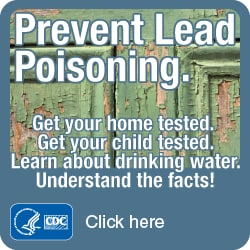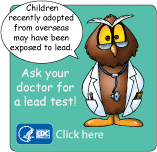Get the Lead Out: National Lead Poisoning Prevention Week 2013
Posted on byJoseph and Gwen Porter are so excited. For several years they have been looking for an older home they can afford. They’ve found a charming 1930s bungalow in a beautiful, tree-lined neighborhood with plenty of room for their three children. But when they read the seller’s disclosure required by law, they are surprised to learn that the home contains lead paint.
The Porters know that lead exposure is dangerous for children, but they also know that lead paint was banned years ago. They discover, however, that many older homes still contain lead paint that can contaminate house dust. The Porters also learn that lead exposure continues to be a public health concern.
Facts about lead exposure
- Houses built before lead-based paints were banned in 1978 are likely to contain some lead-based paint.
- About 24 million homes in the U.S. contain deteriorated lead-based paint and elevated levels of lead-contaminated house dust.
- About 4 million homes with elevated lead levels are home to young children.
- An estimated 535,000 U.S. children ages 1-5 years have blood lead levels known to damage health.
- For each seriously lead-poisoned child, medical and special education costs average over $5,600.
Other sources of lead exposure
Besides peeling and cracking lead paint and dust, children can come into contact with lead in other ways. Some water pipes contain lead, as well as some toys and toy jewelry, imported candy, and traditional home remedies. In addition, adults that work in occupations involving lead, such as mining or manufacturing, may accidentally bring lead into their homes from products they use at work. Some hobbies, like making stained glass, also use lead.
Dangers to children’s health from lead exposure
Exposure to lead can seriously harm a child’s health. Children can swallow lead or they can breathe lead in household dust, frequently during home renovation and repair. Even at low levels, lead exposure can cause damage to the brain and nervous system, slowing growth and development and lowering IQ. It can lead to problems with hearing and speech, behavior, paying attention and learning.
The great news is that lead poisoning is 100% preventable. Follow these steps to make your home lead-safe:
- Talk to your child’s doctor about a simple blood lead test.
- Talk to your local health department about testing paint and dust in your home for lead if you live in a home built before 1978.
- If you see paint chips or dust in windowsills or on floors because of peeling paint, clean these areas regularly with a wet mop.
- Renovate safely. Sanding, cutting, replacing windows and other common renovation activities can create hazardous lead dust. To ensure lead-safe renovation, use contractors certified by EPA.
- Remove recalled toys and toy jewelry from children. Stay up-to-date on current toy and toy jewelry recalls by visiting the Consumer Product Safety Commission’s web page.
The Porters are relieved to learn that trained EPA-certified contractors can remove lead paint and dust from their home. With lead removed and their home freshly painted, the Porters can now move into their long-awaited home, knowing that they have protected their children’s health and created a safe place to live.
Resources:
CDC’s National Lead Poisoning Prevention Program




Post a Comment